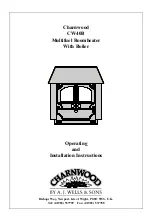
CONNECTIONS TO
FLUES
There are several ways of connecting
the appliance to the flue. These are
illustrated in Figs. 4 to 6. Horizontal
lengths of flue must be kept to a
minimum and should not be more
than 150 mm (6 inches) long. The
sealing face of the flue collar should
be coated with fire cement before
fixing to the body of the stove using
the two screws provided. The
blanking plate should be removed,
sealed with fire cement and refitted,
care being taken to ensure that the
screws are well tightened. All flue
connections must be well sealed.
SOOT DOORS
It is possible to pass a 16” diameter
sweeps brush through the appliance,
but in most installations it will be
necessary to have a soot door to
enable the chimney to be swept. This
may be either in the brickwork of the
chimney or in the register plate.
Various types and positions of soot
doors are shown in Figs. 4 to 6.
CENTRAL HEATING
SYSTEM
The central heating system must
comply with BS:5449 part 1.
If the system is to be a combined
heating and domestic hot water
system then a double feed indirect hot
water storage cylinder to BS:1556
part 1 should be used. In order to
prevent the build up of scale and
corrosion a suitable inhibitor should
be used. The system must be correctly
vented as shown in Figs. 7 and 8.
The height differential between the
header tank and the appliance must
not exceed 15.2 metres (50 feet).
If all four boiler tappings are used
then, if possible, diagonal pairs
should be connected for domestic hot
water and central heating. Where a
common return is used an injector tee
must be incorporated into the system
as shown in Fig. 9. This will ensure
that a good domestic hot water supply
is maintained when the central
heating pump is operating.
The system must incorporate a
gravity circuit which will normally
heat the domestic hot water and at
least one unvalved radiator. When
the appliance is not connected to a
domestic hot water system the
unvalved radiator(s) on the gravity
circuit must have an output of at least
1.0 kW. This is to prevent boiling in
case of pump failure. All pipework in
the primary circuit must be 28 mm
diameter and the gravity flow pipe
must rise continuously from the
boiler to the open vent. Two typical
systems are shown in Figures 7. and
8.
If the appliance is used to heat a
small central heating system then the
heat output to the room from the fire
will be reduced. Fig. 3. shows the
ratio of space heating to water
heating which can be expected.
Fitting a radiator in the same room as
the fire is recommended as it will
allow greater flexibility in the way
that the system is operated as well as
ensuring that there is sufficient heat.
SYSTEM CONTROLS
The circulating pump may be
controlled by means of time switches,
room thermostats or outdoor
thermostats. Radiators may be either
manually or thermostatically
controlled. These controls will all
work in conjunction with the
thermostat on the appliance and the
minimum return thermostat.
We recommend fitting a minimum
return thermostat to the gravity
return and wiring it into the mains
supply to the pump so that if the
gravity return temperature drops
below 45° C then the pump will cut
out. This will help to prevent
condensation forming on the boiler
faces and will thereby increase the
life of the boiler. Use of a minimum
Page 8
CW40B 3/95




























